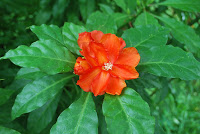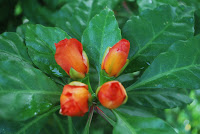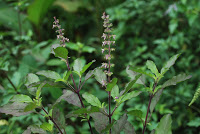 One of my favourite fruity vegetables is the tomatoes, organically grown and vine-ripened since I
One of my favourite fruity vegetables is the tomatoes, organically grown and vine-ripened since I
love them raw with its natural sweetness. I have planted them many times over the years and with each time, I learn more and more. This time around, it looks like the yield will be more and the plants are the healthiest.
Tomatoes, whether ripe or not, are a favourite of many animals from worms and caterpillars to birds including chickens. I have experimented planting them outdoors and in the greenhouse. Due to the nature of my farm, where birds are free, the outdoor experiment resulted in me just feeding them. So, now I only plant them in the greenhouse.
 I plant them from seeds – it germinates in a few days – in the ground. The quality of the seed is important for a good quality tree. From my experiments, I find that unless you obtain vine-ripened tomatoes, the quality of the seed is not good even though it germinates. If it is not vine-ripened, even if the tomato is left to ripen, the seed doesn’t seem to further mature enough to produce good quality plants. Most store-bought tomatoes are picked before it fully ripens, probably due to transportation and distribution time delays. After it has produced 3 or more leaves (after the initial baby leaves which is normally 2 of them), I will transplant most of them into 20 cm diameter polybags, starting them at half full. Through its life cycle, the roots will appear at the top so by starting half-full, it allows for me to cover the roots with more soil without the need to transplant them. I do plant some in the ground but this limits the utilisation of the land and I can plant more tomato plants in polybags and have a more controlled setting.
I plant them from seeds – it germinates in a few days – in the ground. The quality of the seed is important for a good quality tree. From my experiments, I find that unless you obtain vine-ripened tomatoes, the quality of the seed is not good even though it germinates. If it is not vine-ripened, even if the tomato is left to ripen, the seed doesn’t seem to further mature enough to produce good quality plants. Most store-bought tomatoes are picked before it fully ripens, probably due to transportation and distribution time delays. After it has produced 3 or more leaves (after the initial baby leaves which is normally 2 of them), I will transplant most of them into 20 cm diameter polybags, starting them at half full. Through its life cycle, the roots will appear at the top so by starting half-full, it allows for me to cover the roots with more soil without the need to transplant them. I do plant some in the ground but this limits the utilisation of the land and I can plant more tomato plants in polybags and have a more controlled setting.
 |
| Time to top-up the soil |
The soil mixture I use is rich, organic soil – I tend to mix various things and then run my fingers through them to see if it feels right to me. So, please do not ask what the ratios of soil, organic matter,sand, etc are. It has to be able to run through my fingers and not lumpy. I will water immediately upon transplanting, irrespective the time of day. When I see the roots at the soil surface, I will top up with more soil, covering them.
I fertilise weekly, in small amounts, and also spray with home-made organic fertiliser/pest control spray. I experimented over the years and find that this spray works best so for now, my experimenting on the tomato spray is done. It prevents ants, white flies and also other assorted pests. It also seems to improve the health of the plant. I use vermicompost as the “solid” fertiliser which I use about 1 teaspoon weekly per plant. Tomatoes require lots of water for nice luscious fruits but not soggy, muddy soil so it is important that the soil contains enough organic matter to hold water and not suffocated the roots with mud-like sludge. I water them twice a day on hot days, once early morning before 9am and once again in the late afternoon and on cool, rainy days, once in the morning.
The white flies are the most notorious to me followed by the

 caterpillar. The white flies lay eggs at the bottom of the leave and these babies then seem to suck the life out of the leaves, causing them to yellow and wither. The spray I use addresses this problem and I have to be diligent about spraying it once a week. In between sprays, I also water spray them off should I notice them. Since this spray is non-toxic and provides lots of benefits, I have now started spraying them twice a week so I have to continuously prepare more concentrate. The EM concentrate is made by mixing vegetarian kitchen wastes such as papaya skins and other fruit skins and pulp, tomato skins, vegetable stems, with molasses and fermenting them for 3 months in an air-tight container. Weekly, I will open the lid of the container to release the gases produced by the fermentation process. To create the spray, I mix approximately 100ml of the concentrate to 1 litre of water with a flat-teaspoon of Epsom salts. I also sometime mix in some serai wangi juice to add additional pest deterrent properties.
caterpillar. The white flies lay eggs at the bottom of the leave and these babies then seem to suck the life out of the leaves, causing them to yellow and wither. The spray I use addresses this problem and I have to be diligent about spraying it once a week. In between sprays, I also water spray them off should I notice them. Since this spray is non-toxic and provides lots of benefits, I have now started spraying them twice a week so I have to continuously prepare more concentrate. The EM concentrate is made by mixing vegetarian kitchen wastes such as papaya skins and other fruit skins and pulp, tomato skins, vegetable stems, with molasses and fermenting them for 3 months in an air-tight container. Weekly, I will open the lid of the container to release the gases produced by the fermentation process. To create the spray, I mix approximately 100ml of the concentrate to 1 litre of water with a flat-teaspoon of Epsom salts. I also sometime mix in some serai wangi juice to add additional pest deterrent properties.
 |
| Caterpillar and what is left of the fruit |
The caterpillars can munch their way through lots of leaves and also the fruit, leaving just the skin of the fruit. It is quite amazing to see them munching their way through. Whilst butterflies may be beautiful, they are a great pest to this plants and their babies, the caterpillars are monster leave and fruit eaters. Then we have the ants, which creates like a white cocoon to place their eggs where the babies will then such the sap out of the stem, effectively slowly killing the plant. I also periodically remove any leaves that have signs of pests or “illness” to prevent it from spreading to the rest of the plant and I also remove old or yellowing leaves.

From my experience, tomato plants require support as it fruits or you will end up with broken stems as it cannot support the weight. I will wind “talk raffia” around the stems to support the stems. This time around, this is something that I diligently need to do as the plants are producing substantial fruits. Just placing a stake to support the main stem is insufficient, I need to support the fruiting branches also. When planted in a pot and if you would like for it to be free-standing and easy to move around for your landscaping, I find using a T-shaped stake is best as it allows to the main stem to be supported as well as allow you to attaches strings and fine ropes from the top T to the fruiting branches. From seeding to this point in fruiting, it took about 2 months.
 I love watching the fruit turn from green to yellow to orange before finally vine-ripening to a red colour. Once the fruit turns yellow, it takes a few days before becoming red and then it is at its prime in taste. Each bunch can contain several tomatoes and they do not all ripen at the same time. You can use these seeds to start a new generation of plants. I dry them first and this allow me the option to sow the seeds when I want to. When picked at its prime, you can store in the refrigerator for at least two weeks without significant degradation of taste and juiciness.
I love watching the fruit turn from green to yellow to orange before finally vine-ripening to a red colour. Once the fruit turns yellow, it takes a few days before becoming red and then it is at its prime in taste. Each bunch can contain several tomatoes and they do not all ripen at the same time. You can use these seeds to start a new generation of plants. I dry them first and this allow me the option to sow the seeds when I want to. When picked at its prime, you can store in the refrigerator for at least two weeks without significant degradation of taste and juiciness.
Updates: March 15, 2015
























































